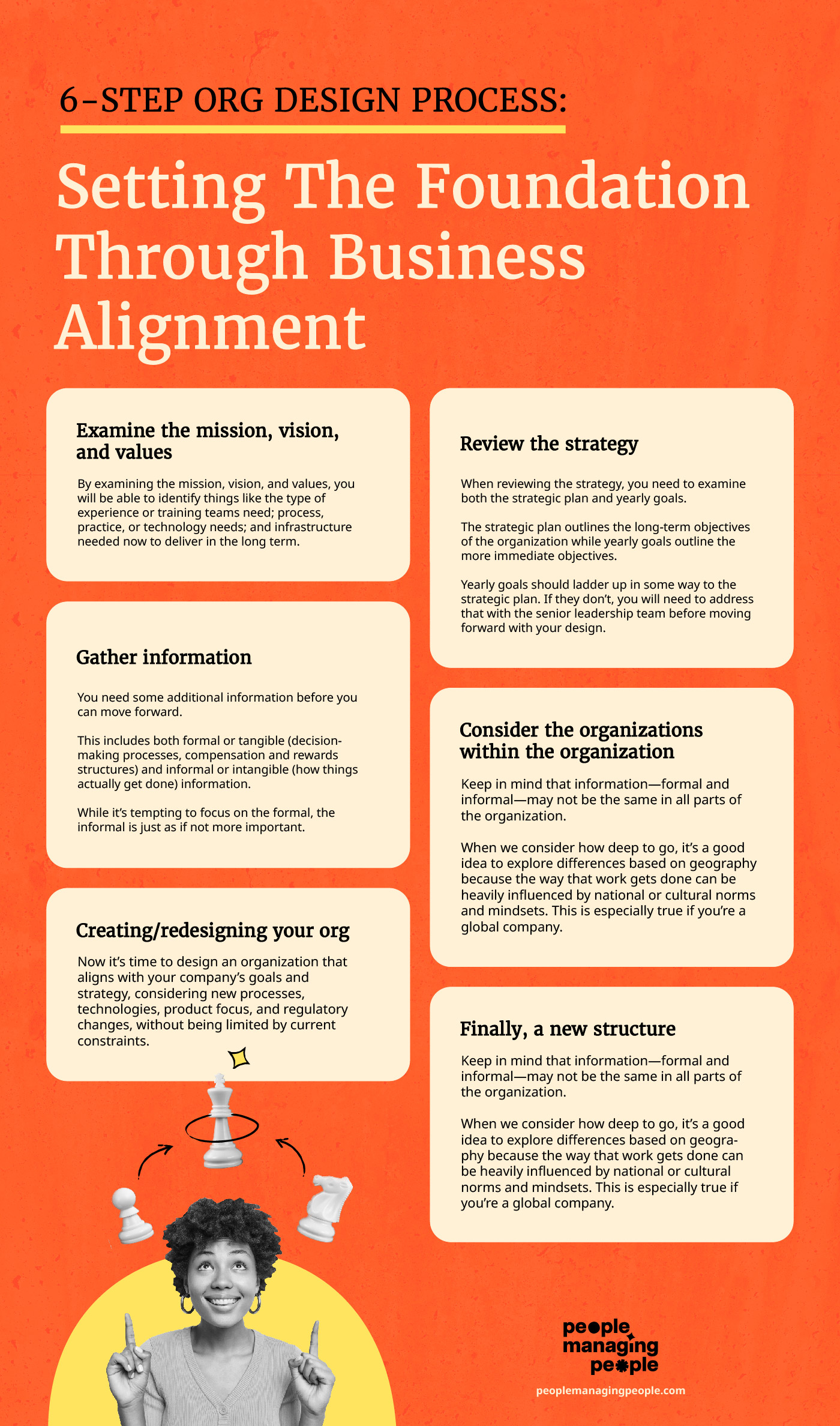Organizational design is a comprehensive process that aims to optimize and align multiple facets of an organization including functions, processes, and structure.
Many organizations focus on changing the structure (essentially the organizational chart) without truly redesigning the organization.
As we’ll discuss, a global retailer I worked for approached it this way and it resulted in a lot of issues.
Here I’ll share what organizational design is, some best practices, and a process to help you get it right.
What Is Organizational Design?
Organizational design (sometimes org design or OD) is a methodology for identifying multiple aspects of an organization (e.g. mission, workflow, strategy) and then aligning or realigning them to meet organizational goals in the current business environment.
It is often triggered by significant internal or external changes including:
- Shifts to the company mission or strategy
- Environmental disruption (ex: risks driven by climate change)
- Advances in technology (ex: increased automation)
- New competitors
- Legislative changes
- Significant changes to business results (positive or negative)
- New leadership.
True org design aims to optimize the functions, processes, and company structure to achieve business results.
A well-designed organization can adapt to change, collaborate cross-functionally, make and execute decisions effectively, and nurture a positive working environment.
Often, people mistake org design for redesigning the org structure with their org chart tools.
In reality, the outcome of the OD process is a series of recommendations that can be quite broad and include things like organizational structure, technology needs, compensation model updates, policy changes, and shared behaviors.
Potential positive outcomes from these recommendations include:
- Improved profitability
- Increased employee engagement
- Strong employee retention and career pathing
- Better products and services
- Increased customer acquisition and/or loyalty
- Better preparation for future change and growth.
HR’s Role In Leading The Org Design Process
HR plays a crucial role in org design. In companies with OD professionals on staff, they’ll lead the process and act as both experts and project managers. In companies without OD partners, the HR business partners are commonly tasked with this work.
Often the biggest challenge teams face is guiding business leaders to support and participate in a complete org design process and not just jump to create new org charts.
They also need to balance an approach that is both business and people-focused.
Organization Design Principles
Before starting your org design process, it’s helpful to first ground yourself and your team in a few key principles:
- Business alignment first, structure last
- Learn from the past but don’t be tied to it
- Aim to retain top talent but don’t design around them
- Design for flexibility
- Design for clarity
Business alignment first, structure last
Because people mistakenly use “org design” and “org structure” interchangeably, they often want to start with structure. Structure is an outcome—it’s one of the ways that you will help to bring the design to life.
Business alignment is the most comprehensive and important part of the org design process because it sets the foundation for all of the design choices–including structure–you will make.
Learn from the past but don’t be tied to it
While it’s helpful to review past org designs for lessons learned, keep in mind that you’re designing your organization for your needs today and what you anticipate in the future.
Things that may have been true in the past may no longer apply (e.g. too many layers were unhelpful when we started; now that we have doubled in size we are finding that we’re too flat).
Aim to retain top talent but don’t design around them
Talent is a huge investment and can be a competitive advantage. While retention is important, designing an org around a few people does not serve anyone well.
If any of those people leave, you may find that you are left with an org that no longer makes sense.
Design for flexibility
Business can be impacted by conditions beyond our control. While no one can predict the future, creating a design that allows for things like career pathing, new technologies, and continual learning will allow for the org to flex with change without the need for a full redesign.
Design for clarity
In a strong org design, people understand their roles. They know where they fit into the big picture and understand what they are accountable for.
Decision rights are commonly known and people are aware of how information flows in the organization.
6-Step Org Design Process: Setting The Foundation Through Business Alignment
Thorough business alignment is the foundation for successful org design. It’s how we assess whether or not a company is set up to deliver on its strategic goals.
Alignment is a multi-step process. You first need to ground yourself in some core tenets of the business and then do some information gathering.

Examine the mission, vision, and values
The mission, vision, and values shape the purpose and the goals of the strategic plan. They inform things like performance standards, metrics, and behavioral expectations.
Not all companies have all three–or they may have something similar like a purpose statement.
- Mission = what we do (tactical)
- Vision = what we will do (aspirational)
- Values = how we do it (behavioral)
By examining the mission, vision, and values, you will be able to identify things like the type of experience or training teams need; process, practice, or technology needs; and infrastructure needed now to deliver in the long term.
Review the strategy
When reviewing the strategy, you need to examine both the strategic plan and yearly goals.
The strategic plan outlines the long-term objectives of the organization while yearly goals outline the more immediate objectives.
Yearly goals should ladder up in some way to the strategic plan. If they don’t, you will need to address that with the senior leadership team before moving forward with your design.
In addition to understanding the strategy, try to identify the desired performance outcomes, the resources (financial, headcount, or otherwise) needed, and the gap between the current state and the desired future state. This will inform your design recommendations.
Gather information
You need some additional information before you can move forward. This includes both formal or tangible and informal or intangible information.
While it’s tempting to focus on the formal, the informal is just as if not more important.
Formal information includes things like decision-making processes, compensation and rewards structures, communication channels (town halls, e-newsletters, etc.), current hierarchies, and team structures.
Formal elements are explicit, often communicated somewhere (employee portal, handbook, org policies) that people can reference.
Informal information is implicit. You will not find it on the portal or in the staff handbook, but they inform how things actually get done in the organization.
For example, the company standard (formal) may be that decisions get made in specific milestone meetings. In reality, everyone may know that decisions actually get made in ad hoc conversations (informal) before the milestone meeting.
When you’re gathering informal information, look for things like norms, mindsets, commonly held attitudes and beliefs, and networks within the employee population.
Consider the organizations within the organization
Keep in mind that information—formal and informal—may not be the same in all parts of the organization.
When we consider how deep to go, it’s a good idea to explore differences based on geography because the way that work gets done can be heavily influenced by national or cultural norms and mindsets. This is especially true if you’re a global company.
You may also want to look for disparities across function or event-specific teams for a whole host of reasons. Be open to expanding your information gathering based on what you learn throughout the process.
Creating/redesigning your org
Now you’re ready to create your new org design. Again, this does not just mean creating an org structure.
You’re designing an organization that will set the company up to achieve its goals and deliver on the strategic plan.
Your design may include things like:
- New decision-making processes
- New technologies
- Reduction or expansion of product focus
- Changes to keep up with anticipated regulatory changes.
Don’t let current limitations influence your design. Your objective is to figure out what the company needs to make your strategy a reality.
It will be up to the executive leadership team to decide if they’re willing and able to support what is needed.
Finally, a new structure
Now you’re ready to create your org structure. You have the information that you need to create the structure that will bring the rest of the org design to life.
For example, to streamline decision-making across the organization, you may propose a flatter structure with fewer layers.
To ensure that you can hire, retain, and grow the deep bench of technical specialists that you need to promote continuous innovation, you may create a structure where specialists don’t need to become leaders to advance to more senior levels in the organization.
Org Design Case Study
Back to the global retailer I mentioned in the intro. In the close to ten years that I was there, the organization experienced multiple senior leadership changes.
That, combined with other factors like declining sales, new competitors, and increasing materials costs, drove significant changes in strategy approximately every other year.
Rather than HR leading org redesign to comprehensively realign all aspects of the organization to support strategy changes, executive leadership insisted on multiple restructures instead.
Throughout that time, different parts of the organization went through 12 restructures(?!). In one case, a team of 100 people ballooned to close to 400 only to shrink back down less than 18 months later.
During those years, the organization lost talent, incurred significant expense in separation and exit packages, and continued to lose market share.
Decision rights became increasingly unclear, cross-functional partnerships got more difficult, and accountability continued to diminish.
By focusing almost exclusively on structure at the expense of alignment and design, not only did the company not achieve its strategic goals, it worked against itself.
Proper Organizational Design Time Requires Time
A common objection I hear against conducting a full org design process is that it takes too much time and just restructuring is faster.
As an HR professional, it’s your role to help leadership see the value in slowing down to speed up.
While restructuring may seem faster, the opportunity cost of lost efficiency, inadequate or lost talent, lack of clarity across the organization, and eroded accountability will ultimately cost the organization more time (and often more) as they try to fix what isn’t working.
The redesign process is a thoughtful and thorough way to ensure that the organization is set up for success.
Key takeaways
- Organizational design and structure are different. OD involves aligning various aspects of an organization covering processes, workflows, strategies and structure to achieve business goals.
- HR’s important role in design. Human Resources (HR) plays a crucial role in leading the organizational design by ensuring that leadership is committed to re-designing rather than simply restructuring.
- Principles and process of effective organization design: The underlying principles of effective organizational design are business alignment, evolution flexibility, clarity, and talent retention.




